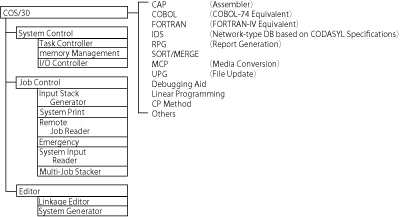- COS/MT
- COS was the OS for TOSBAC-5100/10, released by Toshiba in 1965, and was capable of continuously executing batch jobs using a magnetic tape. A batch job was input from a paper tape reader/card reader, performed the computations required by the business process mainly by means of a magnetic tape, and, then finally, output the computation result to a printer.
Standard hardware comprised the main unit, 16KB main memory, magnetic tape devices (4 units), a paper tape reader or a card reader (1 unit) and a printer (1 unit). The main memory was expandable to up to 32 KB.
The size of the resident area of COS/MT was 2.6 KB. It was kept as small as possible in order to leave enough memory to user area. Major software components comprised the assembler CAP for software development and sort/merge. The OS and the CAP were operable with a minimum main memory of 8 KB. - COS/DS
- TOSBAC-5100/20, released in 1967, was equipped with a magnetic disk-based OS "COS/DS," which was capable of performing full-scale continuous batch jog execution.
With expansion of the main memory to 64 KB and incorporation of COBOL, TOSBAC-5100/20 was virtually a complete business process computer system.
In addition, a database system "IDS" that took full advantage of a magnetic disk was developed. "IDS" stood for “Integrated Database Store.” This served as the mainstay database until a relational database based on a relational model was put into practical application. IDS was a network-type database developed in line with specifications by CODASYL (Conference on Data Systems Languages) in the United States, and used COBOL as the host language. Because IDS was capable of expressing the relationship between records, it was called a "network-type database" or “network database.” It is well known that if there is an n-to-m (n, m>1) relationship between records, it is difficult to express it in a relational model. However, a network-type database was capable of easily expressing this relationship.
The functions of COS/DS were configured as follows:

- Home >
- Historical Computers in Japan >
- Mainframe OS >
- COS
【Toshiba】 COS

Toshiba expanded the business processing function by installing COBOL-74 and enhancing the IDS function, enriched the online function by adopting a full-scale communication controller called "DN-340", and utilized the SWAP-IN/OUT function and the overlay function of the OS to operate a system with the capability to parallel-process up to 64 online jobs.
The functions of COS/30 are configured as follows:
All Rights Reserved, Copyright (C) Information Processing Society of Japan

